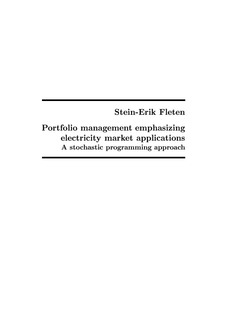| dc.description.abstract | Using a stochastic programming approach, we consider portfolio management problems in the electricity and insurance businesses.
Traditional portfolio management models assume that the markets in which the manager operates are perfectly competitive. There is reason to question this in the case of deregulated electricity markets, which are often dominated by large vertically integrated firms. Employing a two-stage stochastic Cournot-type game model of the Scandinavian electricity market, we investigate the potential for use of market power by large producers. The model takes into account the commitment effect of hydroelectric generation and forward contract decisions. We find that Statkraft, the largest pure hydro producer, has no market power on the seasonal level due to the aggregate hydro capacity of the large number of smaller producers. However, Vattenfall, the largest producer, has incentives to withhold thermal capacity in order to raise prices.
Leaving the potential problems related to market power aside, we consider a price-taking hydropower producer facing uncertainty both in prices and reservoir in ow. Taking the view of a risk averse producer, we propose a portfolio management model for the purpose of hedging the financial risks using electricity contracts and the exibility of the production assets. This is a multistage stochastic programming model, and studying a case with real data from Norway, we find that such a model has the potential to improve the portfolio management processes currently used.
Model verification is a challenging task in stochastic programming. For a portfolio management problem in a Norwegian insurance company, we compare two alternative model approaches. The first is a stochastic programming model, and the second is one where the asset mix is assumed constant, called the fixed mix approach. We explain how such a comparison can be done, considering the fact that in actual use, the models will be rerun before each decision is made. We find that the stochastic programming approach performs only slightly better than the fixed mix approach.
With a stochastic programming approach it is possible to model portfolio management problems where the investment universe can contain derivative assets. We have applied this in an analysis of a casualty insurer's problem where we investigate the use of financial reinsurance, through selected options, in cases where the insurance company considers bearing catastrophe risks. Particular attention has been paid to the prices of the derivatives used in this model, using both arbitrage and equilibrium concepts. | nb_NO |
